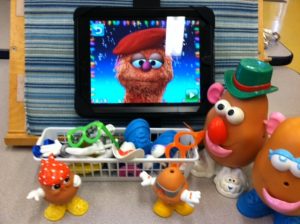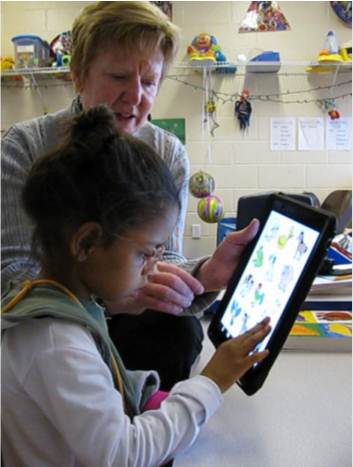Part Three of Cooney Center Fellow Sarah Vaala’s day spent observing children with developmental disabilities and iPads. Part One focused on the affordances of the iPad. Part Two focused on specific skills that are fostered through using an iPad. This post addresses the limitations.

Part One and Part Two of this series have focused on insights gleaned from my visit to the Mary Cariola Children’s Center regarding the unique affordances of the iPad for teaching young children with complex developmental disabilities. However, the staff also pointed to important considerations regarding the amount and nature in which iPads and mobile apps should be used in classrooms, as well as some existing obstacles to their optimal use.

The iPad should be used in limited amounts with targeted goals. Despite the functionality and appeal of the iPad, the teachers at the Mary Cariola are quick to tell you that the device is not just a toy, nor is it any student’s sole means for learning. In fact, the teachers at Mary Cariola carefully plan how apps, used via the iPad, will contribute to each student’s individual educational plan – from communication goals, to academic readiness goals, to social skill goals, and more. Preschool Program Director, Christine Sheffer, reinforced that point, stating that the Mary Cariola preschool staff “uses [the iPad] as part of a child’s individual education program, not as the child’s individual education program.” She stressed that it is crucial to have an explicit reason to use the iPad and to always know what you are using it for. Teachers at Mary Cariola use it in limited amounts, in structured contexts, and as a tool among many in their teaching toolkits.
Apps should be further developed to fit the needs of young learners with developmental disabilities. Christine, Dana (pictured above working with Blessed on an iPad) and the teachers I spoke with pointed out some remaining limitations of the iPad for use in the classroom with their students. If Dana had her way, for example, iPad apps would be more customizable, an advantage maintained by computers. Some of the students she works with may not recognize abstract objects or characters, but they may be able to recognize their own face. A “Make Me a Monster” app that allowed children to add furry noses and funny eyes to their own image would likely be quite a hit! In addition, the Mary Cariola preschool classrooms contain pictures everywhere – a schedule of the day’s events constructed of picture symbols, pictures of classmates’ faces, picture boards for students who are non-verbal to choose activities, picture labels for each room or activity space. The ability to incorporate these pictures within the iPad content could help to streamline learning across a student’s daily activities, and avoid confusion currently encountered when the iPad’s version of an object does not closely resemble the classroom version.
Further advances to the technology itself could aid young users with disabilities. Despite the wooden easels and durable cases, teachers still have difficulty incorporating iPads into instruction with students who have more severe physical or behavioral disabilities. Some students, for example, do not have the motor skills necessary to interact directly with an iPad. These students can use switches, operated through breath control or very slight movements, to operate various technologies (such as wheelchairs or computers). These switch adapters do exist for the iPad as well, and Mary Cariola plans to purchase them when funding permits. Also on the Mary Cariola “wish list” are adapters and programs that would allow the iPad to be operated through eye-gaze systems, opening up more opportunities for students with severe physical disabilities.
Teachers and specialists would benefit from access to greater informational resources which point them toward high-quality apps. The teachers at Mary Cariola put much time and effort into selecting good apps to target the multitude of skills outlined in their students’ individual education plans. They scour the “Education” section of the Apple app store, research the apps’ reviews, check blogs from professional organizations, like Commonsense Media and parent groups, and read books like Apps for Autism (Brady, 2011) to locate high quality apps. Dana and Colleen even try them out at home with their own children, before finally giving new apps a test-run with their students. What would be helpful would be a site which, with students with disabilities in mind, gives detailed ratings and classifications of apps and the specific skills they target. While such reviews are beginning to appear for children who have autism, other developmental delays are largely over-looked. “From our point of view as practitioners, that’s a critical need,” emphasized Christine, “we need more professional reviews of apps for students with disabilities beyond autism.”
Also needed is more efficiency in the process of acquiring the technology and apps for educational institutions. Christine has found also that buying apps in bulk for use in the classroom is not very straight forward and efficient, and Apple’s “Volume Purchase Program” could be more user-friendly and streamlined. In fact, some of the documents need to be sent through the mail to a participating organization before the account can be set up and apps can be purchased and downloaded on multiple devices. Mary Cariola’s tax-free status further complicates the process.
Notably, Steve Jobs maintained that he did not plan or foresee the benefits of the iPad for users with disabilities when designing the device. Instead, it was dedicated teachers and parents who have recognized and exploited the educational and enrichment potential of this new digital technology in the lives of children with developmental disabilities. These advocates continue to work tirelessly to chart the remaining needs and improvements necessary for the iPad to be of optimal benefit to these special learners. Hopefully, academic research will also emerge clarifying and confirming the benefits of such technologies for this population and informing future development in this area. Undoubtedly, we will see the affordances of the iPad and the content of its associated apps continue to evolve in order to better suit the needs of children with developmental disabilities. I hope a “Make Me a Monster” app is in the mix!
Click here to find out more about the Mary Cariola Children’s Center and how you can donate apps or old iPads to their technology program!




